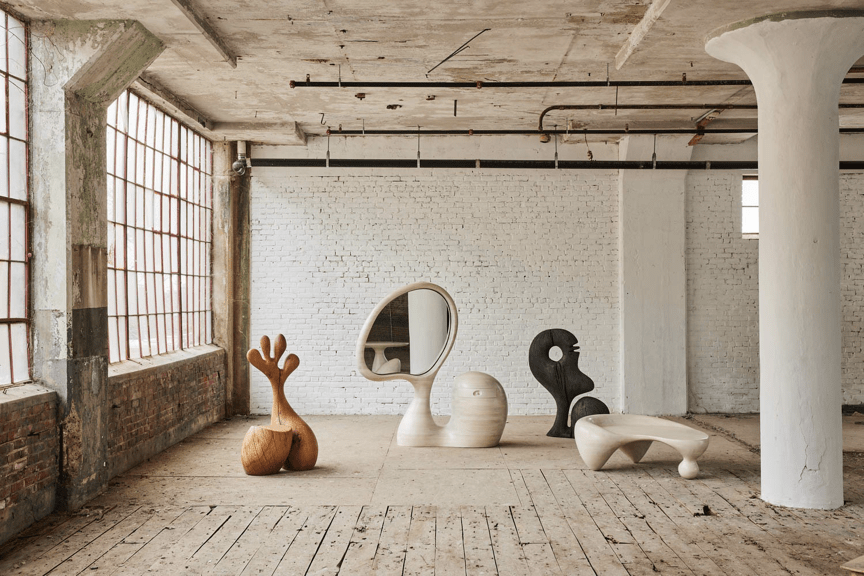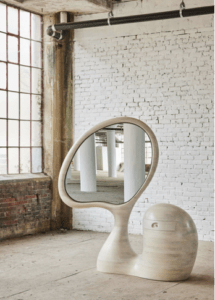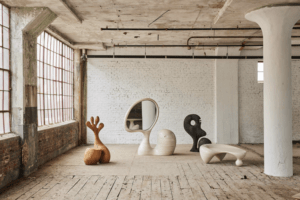
“Big Woods,” an exhibition by designer Aaron Poritz, comprises several pieces of sculptural art furniture made with American hardwoods. Photograph by Nicole Franzen
Up until now, Aaron Poritz, a young Brooklyn-based designer, has been best known for his expertly crafted, high-end hardwood furniture, particularly a collection of cabinets featuring superbly detailed tambour doors. Handmade and built-to-order in woods like black walnut and bleached oak, the credenzas, bars, desks, coffee tables, and other pieces find a balance between elegant simplicity, practical functionality, and striking innovation. But with “Big Woods,” an exhibition of seven witty new sculptural pieces at New York’s Cristina Grajales Gallery, Poritz pushes his work in an excitingly artful, almost surrealistic direction.
A lot of personal experiences and historical influences are combined in the new works, which include a floor mirror, desk, coffee table, stool, floor lamp, and console. Foremost is Poritz’s Massachusetts childhood, much of it spent in his father’s woodshop and sculpture studio, where he developed a passion for understanding how things are made, or in the surrounding woodlands, where he learned to love nature in general and trees in particular. A degree in architecture from California College of the Arts and early work experience at Morris Adjmi Architects account for the assured sense of design the pieces show.
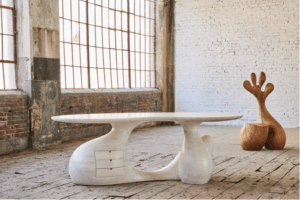
Sculptural, a desk in ash and leather, is shown with the white-oak Hand stool. Photograph by Nicole Franzen
A trip to Nicaragua in 2012 led Poritz to design his first furniture collection, 20 pieces using old-growth trees felled there by a hurricane. Similarly, the American hardwoods he’s selected for the “Big Woods” collection include a 200-year-old oak that fell in Connecticut as well as such characterful timbers and finishes as whitewashed ash and charred white oak. “I think woodworking is a complex craft that requires a deep knowledge of wood and its properties, as well as engineering, patience, and precision,” Poritz said in a 2019 interview. “I grew up building wood furniture, but I could never make any of the furniture I am designing now. It’s far too complex and requires a master craftsman with a ton of experience and knowledge.”
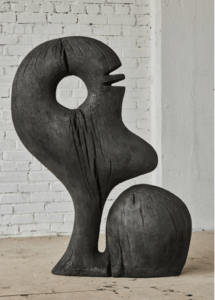
The charred white-oak sculpture Youthful Mistakes is also a dramatic floor lamp. Photograph by Nicole Franzen
The craftspeople in Poritz’s multidisciplinary studio, where design and production unite, definitely have the woodworking chops to make the biomorphic pieces he calls “abstractions of human forms.” Two techniques are used to create the fluid shapes: either ceramic maquettes are digitally scanned and the data fed into computer-governed machines that carve the sculptures from solid blocks of timber; or the pieces are painstakingly built up using stack lamination. Both methods were pioneered by the late Wendell Castle, the great art-furniture maker and spiritual godfather of Poritz’s wonderfully evocative collection.
“Big Woods” is on view through May 26, 2022, at Cristina Grajales Gallery, 50 Vestry Street, New York City.
cristinagrajales.com
instagram.com/cristinagrajalesgallery
Poritz & Studio
poritzandstudio.com
instagram.com/poritzandstudio


